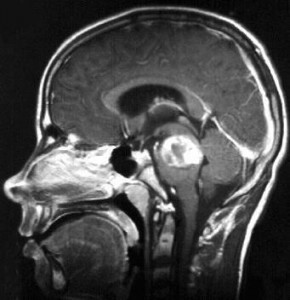Red Sox prospect, Ryan Westmoreland, undergoes brain surgery

It was announced last week that top Red Sox prospect Ryan Westmoreland, 19, would have to undergo brain surgery to treat what was diagnosed as a cavernous malformation, or cavernoma. Westmoreland left Red Sox Minor League camp on March 4 after experiencing headaches and numbness, and was diagnosed the next day at Massachusetts General Hospital. Yesterday he underwent a successful five-hour procedure at the Barrow Neurological Institute at St. Joseph’s Hospital and Medical Center in Phoenix. A team statement reported that Westmoreland remains in the intensive care unit “but has come through the surgery well.” It added that because of the complex nature of the surgery, the outfielder will “face a difficult period initially before beginning his recovery.”
(Photo credit: John Corneau / Lowell Spinners)
What is a Cerebral Cavernous Malformation? (Source: NINDS)
A cerebral cavernous malformation (CCM) is a collection of small blood vessels (capillaries) in the central nervous system (CNS) that is enlarged and irregular in structure and takes the shape of a characteristic honeycomb (or mulberry) pattern. The walls of the CCM capillaries are thinner than normal and less elastic, making them prone to leaking. Cavernous malformations can occur anywhere in the body, but usually only produce symptoms when they are found in the brain and spinal cord. There are familial (inherited) and sporadic (occurring for no clear reason) cases of CCM. Researchers have discovered three different genes associated with CCM. Studies are currently underway to understand the relationship between the mutations of each of these genes and their corresponding symptoms. It is estimated that about 0.5 % of people (1 in 200 people) may have a cerebral cavernous malformation.
What are the symptoms of Cerebral Cavernous Malformations?
About one-fourth people with CCM will never experience any related medical problems. Others will have serious symptoms such as seizures (most commonly), headaches, paralysis, hearing or vision changes, and bleeding in the brain (cerebral hemorrhage).
Is there any treatment?
Seizures are usually treated with antiepileptic drugs. If seizures don’t respond to medication, or there is recurring bleeding in the brain, surgical removal of the lesion(s) using microsurgical techniques is sometimes necessary.
What is the prognosis?
Some people with CCM will never know they have the disorder because they will never experience symptoms. The prognosis for CCM is variable for each individual, since the location and number of lesions determine the severity of the disorder. CCM can be fatal if it causes severe brain hemorrhages.
For more information:
| Resounding Health(tm) Cavernous malformation |




























0 comments